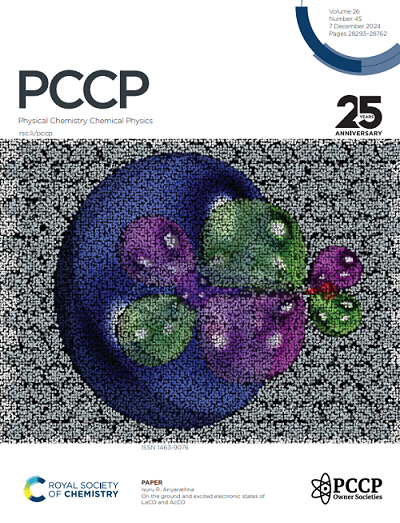氮掺杂石墨烯支撑双原子催化剂上的二氧化碳还原产物的理论认识
IF 2.9
3区 化学
Q3 CHEMISTRY, PHYSICAL
引用次数: 0
摘要
本文章由计算机程序翻译,如有差异,请以英文原文为准。
Theoretical Understanding of CO2 Reduction Products on Nitrogen-Doped Graphene Supported Dual-Atom Catalysts
In recent years, nitrogen-doped graphene supported dual-atom catalysts (DAC@NC) for CO2 reduction reaction (CO2RR) have attracted widespread research interest. Although some DAC structures for deep reduction C1 products and C2 products have been proposed in previous theoretical calculations, the desired products are still difficult to be realized in experiments. This work systematically investigates the reaction pathways and products of CO2 reduction on bimetallic DAC@NC (M1-M2@NC, M1, M2 = Cr, Mn, Fe, Co, Ni, Cu, Ru, Rh, Pd, Ir, and Pt) by first-principles calculations. After excluding improper M1-M2@NC in terms of catalyst poisoning and hydrogen evolution competition, C−C coupling processes always have much higher free-energy increments than the corresponding hydrogenation, making it difficult to form multi-carbon structures. For most of the C1 intermediates on M1-M2@NC, the free-energy increments of C−C coupling are higher than 0.8 eV. Some C1 intermediates could couple with a second carbon, but it is much more difficult than hydrogenation toward C1 products. This work reveals why C2 products are still difficult to be achieved for CO2RR on M1-M2@NC, and identifies the M1-M2 combinations for deep reduction C1 products (methane and methanol), which is inspiring for the future design of CO2RR catalysts.
求助全文
通过发布文献求助,成功后即可免费获取论文全文。
去求助
来源期刊

Physical Chemistry Chemical Physics
化学-物理:原子、分子和化学物理
CiteScore
5.50
自引率
9.10%
发文量
2675
审稿时长
2.0 months
期刊介绍:
Physical Chemistry Chemical Physics (PCCP) is an international journal co-owned by 19 physical chemistry and physics societies from around the world. This journal publishes original, cutting-edge research in physical chemistry, chemical physics and biophysical chemistry. To be suitable for publication in PCCP, articles must include significant innovation and/or insight into physical chemistry; this is the most important criterion that reviewers and Editors will judge against when evaluating submissions.
The journal has a broad scope and welcomes contributions spanning experiment, theory, computation and data science. Topical coverage includes spectroscopy, dynamics, kinetics, statistical mechanics, thermodynamics, electrochemistry, catalysis, surface science, quantum mechanics, quantum computing and machine learning. Interdisciplinary research areas such as polymers and soft matter, materials, nanoscience, energy, surfaces/interfaces, and biophysical chemistry are welcomed if they demonstrate significant innovation and/or insight into physical chemistry. Joined experimental/theoretical studies are particularly appreciated when complementary and based on up-to-date approaches.
 求助内容:
求助内容: 应助结果提醒方式:
应助结果提醒方式:


